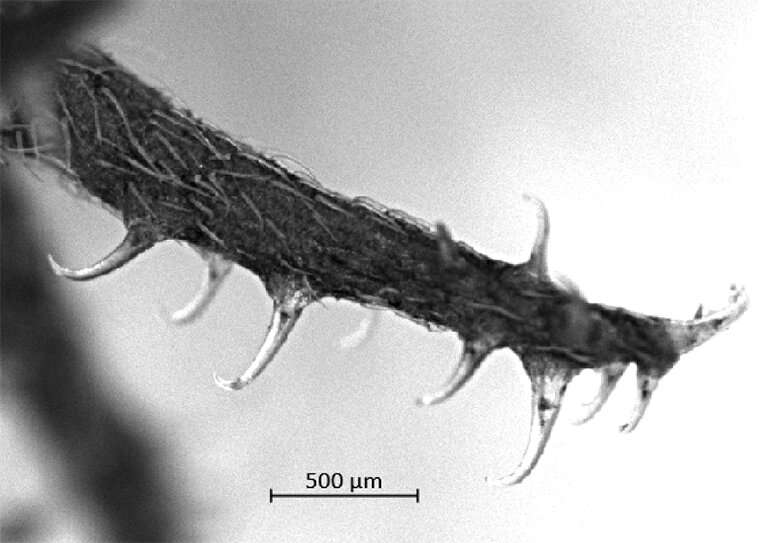Hitchhiker plants inspire improved techniques for reattaching tendon to bone

For most people, getting burrs stuck to your clothes during a hike is nothing more than a nuisance, something to pick off and throw out when you get home. But for scientists at the Center for Engineering MechanoBiology (CEMB), the hooks on these little hitchhikers are inspiring new suturing schemes for surgical reattachment of tendon to bone.
Tendon-to-bone reattachment is required in many surgical procedures, perhaps most commonly in repairing torn rotator cuff tendons in the shoulder, a condition that will affect more than 30% of the population over 60. Current suturing methods fail to distribute stress evenly, leading to failure rates as high as 94% due to ineffective attachment and re-tearing of sutures.
A team of researchers led by Guy Genin, co-director of the CEMB and the Harold and Kathleen Faught Professor of Mechanical Engineering at the McKelvey School of Engineering at Washington University in St. Louis, has developed a new approach to suturing based on the mechanics and spacing of a hitchhiker plant’s attachment system. Their strategies show promise for balancing forces across sutures, reducing the stress on healing tendons and potentially doubling repair strength over current suturing schemes.
The findings were published March 1 in Proceedings of the Royal Society A.
“At CEMB, we’re constantly thinking about critical issues in medical practice and working to bring together people from across disciplines to work on these big problems,” Genin said. “When the late, great Barbara Pickard, a pioneer of mechanobiology who helped found the CEMB, got these burrs on her socks during a walk through the desert, she didn’t simply discard them; she latched onto this idea that nature could provide novel solutions in unexpected places.”
Decades after Pickard’s walk, she shared her experience with burrs—similar to the hitchhiker plants that inspired hook-and-loop fastener technology—with Genin and his graduate student, Ethan D. Hoppe, lead author on the new study. For Genin and Hoppe, this was a kind of “eureka” moment.
Genin, Hoppe and their collaborators had been studying the surgical reattachment of tendon to bone for years. They wondered, could a burr’s method of balancing forces be used in the repair of tissues?
To test this, Hoppe set out to grow some of the hitchhiker plant Pickard had encountered, Harpagonella palermi, and analyze the unique array of hooks on its fruits. Unfortunately, H. palermi is only found in a few remote patches of southwestern desert. “Your local garden store doesn’t carry these,” Hoppe noted.
After a long search, the team found collaborator Matt Guilliams, a plant systematist and curator of the Clifton Smith Herbarium at the Santa Barbara Botanic Garden, which curates native California plant species. “After Matt sent us some of the fruits he had harvested and we were able to look at them closely, we knew that we had something interesting,” Hoppe said. “The spacing and stiffness of H. palermi’s burrs were unusual, and we set out to model how they hold on to soft materials so reliably.”
The mathematical model the team developed pointed to a unique scheme that balances forces.
“When surgeons repair something like a rotator cuff, they remove all the body’s natural connectors, which have evolved for the complex task of transitioning from hard bone to soft tendon, and put in sutures that concentrate force in a tiny area. That’s what leads to the high failure rate we see for that procedure,” Hoppe said. “Nature has already shown us how hard materials, like the stiff hooks on a burr, can attach very effectively to soft materials like socks or a dog’s fur. We just needed to do the stress analysis to figure out how burrs compare to sutures and how this natural solution might be applied in medical practice.”
Indeed, nature’s solution to a common attachment issue may prove effective in overcoming one of the greatest challenges in orthopedic surgery. The team found that H. palermi simply and effectively balanced forces across attachment points, even when the points of connection were relatively few and the materials were substantially different. Using the mathematical model they developed to assess changes in suturing procedure based on the mechanics of hitchhiker plants, the team is now evaluating new suturing methods.
Pre-clinical testing of the new suturing methods already is underway in the laboratory of co-author Stavros Thomopoulos, the Robert E. Carroll and Jane Chace Carroll Professor at Columbia University and director of Carroll Laboratories for Orthopedic Surgery.
“We are very excited to implement this concept in a real-world surgical setting,” Thomopoulos said. “Current experiments in the laboratory are evaluating how suture spacing inspired by hitchhiker plants affects rotator cuff repair strength.”
More information:
Ethan D. Hoppe et al, A discrete shear lag model of the mechanics of hitchhiker plants, and its prospective application to tendon-to-bone repair, Proceedings of the Royal Society A: Mathematical, Physical and Engineering Sciences (2023). DOI: 10.1098/rspa.2022.0583
Journal information:
Proceedings of the Royal Society A
Source: Read Full Article


